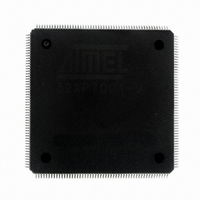AT32AP7001-ALUT Atmel, AT32AP7001-ALUT Datasheet - Page 177

AT32AP7001-ALUT
Manufacturer Part Number
AT32AP7001-ALUT
Description
IC MCU 32BIT AVR32 208-LQFP
Manufacturer
Atmel
Series
AVR®32 AP7r
Specifications of AT32AP7001-ALUT
Core Processor
AVR
Core Size
32-Bit
Speed
150MHz
Connectivity
EBI/EMI, I²C, MMC, PS2, SPI, SSC, UART/USART, USB
Peripherals
AC'97, DMA, I²C, POR, PWM, WDT
Number Of I /o
90
Program Memory Type
ROMless
Ram Size
32K x 8
Voltage - Supply (vcc/vdd)
1.65 V ~ 1.95 V
Data Converters
D/A 2x16b
Oscillator Type
Internal
Operating Temperature
-40°C ~ 85°C
Package / Case
208-LQFP
Data Bus Width
32 bit
Data Ram Size
32 KB
Interface Type
EBI, ISI, MCI, PS2, SPI, TWI, USB
Maximum Clock Frequency
150 MHz
Number Of Programmable I/os
90
Number Of Timers
3
Maximum Operating Temperature
+ 85 C
Mounting Style
SMD/SMT
Minimum Operating Temperature
- 40 C
On-chip Dac
16 bit, 1 Channel
Package
208PQFP
Device Core
AVR32
Family Name
AT32
Maximum Speed
150 MHz
Operating Supply Voltage
1.8 V
For Use With
ATAVRONEKIT - KIT AVR/AVR32 DEBUGGER/PROGRMMRATNGW100 - KIT AVR32 NETWORK GATEWAYATSTK1000 - KIT STARTER FOR AVR32AP7000
Lead Free Status / RoHS Status
Lead free / RoHS Compliant
Eeprom Size
-
Program Memory Size
-
Lead Free Status / Rohs Status
Details
Available stocks
Company
Part Number
Manufacturer
Quantity
Price
Company:
Part Number:
AT32AP7001-ALUT
Manufacturer:
EVERLIGHT
Quantity:
12 000
- Current page: 177 of 829
- Download datasheet (12Mb)
18.8.1
18.8.1.1
18.8.1.2
18.8.2
32015G–AVR32–09/09
Software Handshaking
Hardware Handshaking
Burst Transactions
Single Transactions
Software selects between the hardware or software handshaking interface on a per-channel
basis. Software handshaking is accomplished through memory-mapped registers, while hard-
ware handshaking is accomplished using a dedicated handshaking interface.
When the slave peripheral requires the DMACA to perform a DMA transaction, it communicates
this request by sending an interrupt to the CPU or interrupt controller.
The interrupt service routine then uses the software registers to initiate and control a DMA trans-
action. These software registers are used to implement the software handshaking interface.
The HS_SEL_SRC/HS_SEL_DST bit in the CFGx channel configuration register must be set to
enable software handshaking.
When the peripheral is not the flow controller, then the last transaction registers LstSrcReg and
LstDstReg are not used, and the values in these registers are ignored.
Writing a 1 to the ReqSrcReg[x]/ReqDstReg[x] register is always interpreted as a burst transac-
tion request, where x is the channel number. However, in order for a burst transaction request to
start, software must write a 1 to the SglReqSrcReg[x]/SglReqDstReg[x] register.
You can write a 1 to the SglReqSrcReg[x]/SglReqDstReg[x] and ReqSrcReg[x]/ReqDstReg[x]
registers in any order, but both registers must be asserted in order to initiate a burst transaction.
Upon completion of the burst transaction, the hardware clears the SglReqSrcReg[x]/SglReqD-
stReg[x] and ReqSrcReg[x]/ReqDstReg[x] registers.
Writing a 1 to the SglReqSrcReg/SglReqDstReg initiates a single transaction. Upon completion
of the single transaction, both the SglReqSrcReg/SglReqDstReg and ReqSrcReg/ReqDstReg
bits are cleared by hardware. Therefore, writing a 1 to the ReqSrcReg/ReqDstReg is ignored
while a single transaction has been initiated, and the requested burst transaction is not serviced.
Again, writing a 1 to the ReqSrcReg/ReqDstReg register is always a burst transaction request.
However, in order for a burst transaction request to start, the corresponding channel bit in the
SglReqSrcReg/SglReqDstReg must be asserted. Therefore, to ensure that a burst transaction is
serviced, you must write a 1 to the ReqSrcReg/ReqDstReg before writing a 1 to the SglReqSr-
cReg/SglReqDstReg register.
Software can poll the relevant channel bit in the SglReqSrcReg/ SglReqDstReg and ReqSr-
cReg/ReqDstReg registers. When both are 0, then either the requested burst or single
transaction has completed. Alternatively, the IntSrcTran or IntDstTran interrupts can be enabled
and unmasked in order to generate an interrupt when the requested source or destination trans-
action has completed.
Note:
There are 11 hardware handshaking interfaces between the DMACA and peripherals. Refer to
the module configuration chapter for the device-specific mapping of these interfaces.
The transaction-complete interrupts are triggered when both single and burst transactions are
complete. The same transaction-complete interrupt is used for both single and burst transactions.
AT32AP7001
177
Related parts for AT32AP7001-ALUT
Image
Part Number
Description
Manufacturer
Datasheet
Request
R

Part Number:
Description:
DEV KIT FOR AVR/AVR32
Manufacturer:
Atmel
Datasheet:

Part Number:
Description:
INTERVAL AND WIPE/WASH WIPER CONTROL IC WITH DELAY
Manufacturer:
ATMEL Corporation
Datasheet:

Part Number:
Description:
Low-Voltage Voice-Switched IC for Hands-Free Operation
Manufacturer:
ATMEL Corporation
Datasheet:

Part Number:
Description:
MONOLITHIC INTEGRATED FEATUREPHONE CIRCUIT
Manufacturer:
ATMEL Corporation
Datasheet:

Part Number:
Description:
AM-FM Receiver IC U4255BM-M
Manufacturer:
ATMEL Corporation
Datasheet:

Part Number:
Description:
Monolithic Integrated Feature Phone Circuit
Manufacturer:
ATMEL Corporation
Datasheet:

Part Number:
Description:
Multistandard Video-IF and Quasi Parallel Sound Processing
Manufacturer:
ATMEL Corporation
Datasheet:

Part Number:
Description:
High-performance EE PLD
Manufacturer:
ATMEL Corporation
Datasheet:

Part Number:
Description:
8-bit Flash Microcontroller
Manufacturer:
ATMEL Corporation
Datasheet:

Part Number:
Description:
2-Wire Serial EEPROM
Manufacturer:
ATMEL Corporation
Datasheet:











